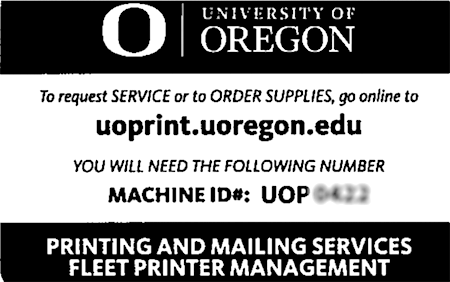Requesting Supplies
Supplies can be ordered without the need to contact technology services.
Find the managed printer program sticker on your device:
Image
- Go to UOprint -> Copier & Printers tab -> Service, Supplies & Training button
- Fill out the form using the Machine ID# (from the sticker)
- Be sure to use name, phone and email that will route service or supplies to their proper location
Requesting Service
For service we encourage you to open a ticket with technology services so we can facilitate access to the device.
Be sure to include:
- Machine ID# (from the sticker)
- printer location
History
In March of 2018, Printing and Mailing Services along with Purchasing and Contracting Services (PCS) executed a strategic purchasing and maintenance agreement for enterprise-wide managed print services for desktop printers for the campus. Similar to the fleet copier program, the managed print services program is designed to consolidate toner and maintenance costs for desktop printers into one contract to take advantage of the University’s buying power under a single agreement. Participation in the program is mandatory per the contract that the campus has signed with CTX.
Managed Print Service (MPS) includes:
- All toner and other consumables (except paper)
- Complimentary replacement of printers not serviceable under the contract (inkjet printers, certain other printers by manufacture)
- All maintenance and repair of printers on the program
- Four-hour response time from on-site CTX support staff
The cost of the managed print service is based on per-click usage. "Per-click" refers to a single-sided image, text or picture, printing on a piece of paper. The "per-click" rate is the cost of each single-sided page printed. And page referring to a standard letter paper size. Per-click charges vary depending on manufacturer. For most, printer owners will be charged monthly for an "average" expected monthly usage, which will then be adjusted quarterly after reporting actual usage.
